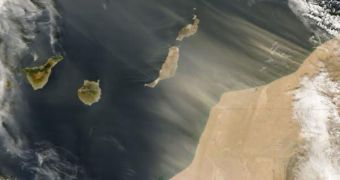A team of researchers will spend the next three years trying to determine precisely how more than 770 million tons of dust influence the global environment.
The investigation will be conducted on a very large database of knowledge, which will be augmented by satellite studies and past climate models.
Every single year, climatologists say, a vast amount of sand and dust is blown off the coasts of Africa, from the Sahara Desert, and over the Atlantic Ocean.
From then on, it spreads around the globe, but affects the Americas most. Scientists now want to understand the mechanisms at work here in greater detail, using the famous NASA A-Train.
One of the main things about these vast amounts of dust that are being cast off Africa yearly is that they contribute to a great extent to Earth's energy budget. They may also play a role in climate change.
Despite these possibilities, until now, the phenomenon has not been studied in great detail. Now, experts supported by NASA will begin a long-term study of these atmospheric events.
“The people who build climate models make some assumptions about dust and its impact on the climate,” explains University of Alabama in Huntsville professor of atmospheric science Dr. Sundar Christopher.
The expert is the recent recipient of a $500,000 grant from the Cloud-Aerosol Lidar and Infrared Pathfinder Satellite Observations (CALIPSO) mission.
The Earth-observations satellite is managed by experts at the NASA Langley Research Center, in Hampton, Virginia. Its main job is to analyze the structure of clouds and atmospheric aerosols.
Its primary science mission is to determine how these particles influence air quality, weather and climate around the planet. The NASA Aqua satellite will also be used in the research.
The two spacecrafts are part of the Afternoon Constellation (A-Train), a group of several observations satellites that fly on the same orbital path, one after the other.
Because they work together, these instruments can provide experts with a much clearer view of Earth's atmosphere than any single satellite ever could.
“We want to learn more about the characteristics of this dust, its concentrations in the atmosphere and its impact on the global energy budget so we can replace those assumptions with real data,” Christopher explains.
“There has been a lot of research looking at the climate effects of man-made aerosols. Particles from smoke and burning fossil fuels are tiny, sub-micron size,” he adds.
“Many of these tiny particles cool the atmosphere because they reflect sunlight back into space before it has a chance to heat the air. That means less solar energy is available at the surface to heat the planet,” Christopher concludes.

 14 DAY TRIAL //
14 DAY TRIAL //